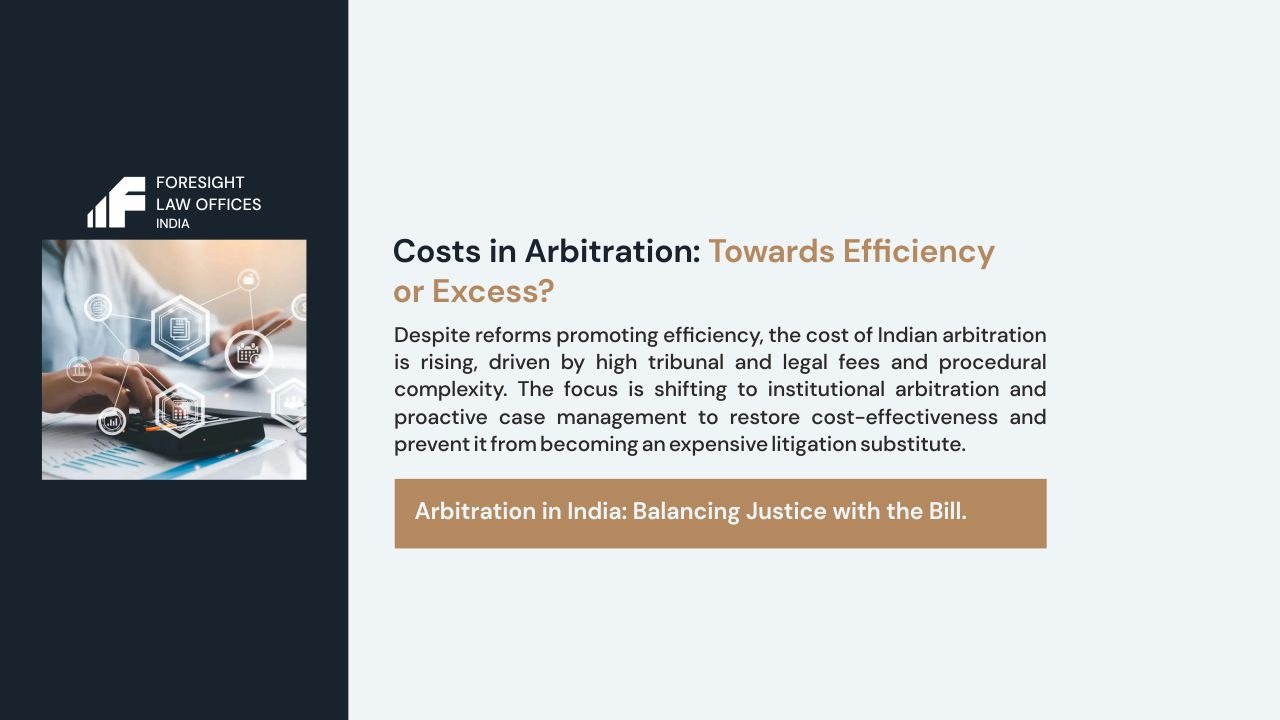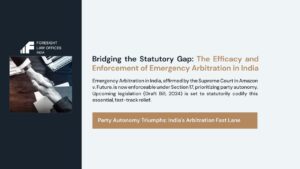Arbitration has long been celebrated as a faster, more flexible, and cost-efficient alternative to traditional court litigation. However, as commercial arbitration in India continues to evolve and gain prominence, one recurring concern has begun to emerge: the rising cost of arbitration. While parties once turned to arbitration to save time and money, many now find themselves questioning whether the process has truly remained efficient or has become increasingly expensive, i.e., the cost in Arbitration.
This blog explores how the cost of arbitration is determined, what drives these expenses upward, how Indian courts and arbitral institutions are responding, and what measures can ensure that arbitration remains an effective mechanism for dispute resolution rather than an expensive alternative to litigation.
The Framework of Costs in Arbitration
Under Indian law, the framework governing arbitral costs is primarily derived from the Arbitration and Conciliation Act, 1996 (“the Act”), as amended in 2015 and 2019. Section 31(8) of the Act empowers arbitral tribunals to determine costs, while Section 31A, introduced through the 2015 amendment, lays down a comprehensive regime for costs.
This statutory provision brought Indian arbitration closer to international standards by adopting the “costs follow the event” principle. This means that the losing party is generally required to bear the reasonable costs incurred by the winning party, including:
- The fees of the arbitral tribunal,
- The administrative costs of the institution (in case of institutional arbitration),
- The costs of legal representation, and
- Any other expenses related to the arbitration proceedings.
By codifying the principle of awarding costs, the legislature intended to promote cost discipline among parties and discourage frivolous claims or defenses.
The Reality: Escalating Costs in Practice
Despite these statutory reforms, parties to commercial arbitration frequently report that the cost of arbitration has grown significantly in India. What explains this paradox?
(a) Tribunal Fees and Institutional Costs
One of the most visible contributors to rising costs is the fee structure of arbitrators. In ad hoc arbitrations, still the most common form in India, arbitrator fees are often negotiated directly between the parties and the tribunal, leading to inconsistencies and unpredictability.
In response, the Fourth Schedule of the Arbitration Act (introduced in 2015) sought to bring some uniformity by prescribing a model fee structure for arbitrators in domestic, ad hoc cases. However, since the Schedule is only recommendatory, not mandatory, its impact has been limited.
Institutional arbitration, on the other hand, typically follows a fixed schedule of fees, such as those prescribed by the Mumbai Centre for International Arbitration (MCIA) or the Delhi International Arbitration Centre (DIAC). While institutional arbitration brings greater transparency and administrative support, it also introduces institutional fees, which can further increase overall costs.
(b) Arbitration Lawyers and Legal Costs
The role of the arbitration lawyer is indispensable in ensuring effective representation and procedural compliance. However, the specialized nature of arbitration advocacy, often involving complex commercial disputes, means that lawyers’ fees can form a substantial portion of the total expenses.
Leading law firms in India with established arbitration practices typically charge premium rates for their expertise, especially in high-stakes commercial arbitration. Moreover, since arbitration often involves detailed pleadings, voluminous documentary evidence, and multiple hearings, the cumulative legal costs can be significant.
(c) Procedural Complexity and Delays
Although arbitration is designed to be faster than litigation, procedural inefficiencies can cause unexpected delays and cost overruns. Parties may engage in extensive discovery, multiple rounds of written submissions, and prolonged hearings, all of which increase the overall cost.
Moreover, challenges to arbitral awards under Section 34 of the Act and appeals under Section 37 can further prolong the dispute, adding to both time and expense.
The Indian Courts’ Perspective on Costs
Indian courts have increasingly emphasized that arbitration must remain cost-effective and not degenerate into a costly litigation substitute. In ONGC v. Western GECO International (2014) 9 SCC 263 and subsequent cases, the Supreme Court underscored the importance of judicial restraint in interfering with arbitral awards, aiming to reduce post-award litigation costs.
More recently, courts have encouraged the application of the “costs follow the event” principle in arbitral proceedings. In Union of India v. M/s. Singh Builders Syndicate (2009), the Supreme Court observed that unregulated arbitrator fees could deter parties from choosing arbitration, especially small and medium enterprises. This concern eventually influenced the 2015 Amendment Act, which introduced the Fourth Schedule.
By contrast, in ONGC Ltd. v. Afcons Gunanusa JV (10 SCC 660, 2022 SCC OnLine SC 1122), the Court further clarified the scope of tribunal fees, holding that arbitrators cannot unilaterally determine their own fees beyond what is agreed upon by the parties. This was an important step toward cost transparency and fairness.
International Comparisons and the “Arbitration Seat” Factor
The arbitration seat, the legal jurisdiction governing the arbitration, plays a crucial role in determining procedural rules and cost structure.
When Indian parties choose foreign seats like Singapore, London, or Dubai, they often face substantially higher institutional and professional costs, including arbitrator fees denominated in foreign currency. However, many opt for these seats because of perceived neutrality, speed, and quality of administration.
In contrast, choosing an Indian seat of arbitration, especially through established institutions like MCIA or DIAC, can offer comparable procedural rigor at lower cost. Yet, the choice often depends on the nature of the dispute, the location of the parties, and their confidence in local enforcement mechanisms.
The challenge for India, therefore, is to enhance domestic arbitral institutions to ensure both cost-efficiency and procedural credibility, making India a globally attractive arbitration seat.
Efficiency Initiatives and Institutional Reforms
Recognizing the need to control arbitration expenses, several reforms and best practices have emerged in India and abroad.
(a) Promoting Institutional Arbitration
The Indian government and the Supreme Court have repeatedly endorsed institutional arbitration as a more efficient and predictable model. Institutions such as the MCIA, DIAC, and Nani Palkhivala Arbitration Centre (NPAC) have adopted transparent fee schedules and time-bound procedures.
Institutional arbitration can ensure cost predictability through standardized fee scales, strict timelines, and administrative oversight, reducing opportunities for inefficiency.
(b) Streamlining Procedures
The 2019 Amendment Act introduced strict timelines for completion of arbitral proceedings: 12 months from the date of completion of pleadings, extendable by six months with consent of the parties. These deadlines, if adhered to, can significantly reduce procedural costs.
Further, tribunals and arbitration lawyers can adopt technology-driven practices, such as virtual hearings, electronic submissions, and online document management, to cut down logistical expenses.
(c) Cost Allocation and Sanctions
Tribunals can actively manage costs by allocating them based on party conduct. Section 31A empowers tribunals to consider factors such as unreasonable delays, frivolous claims, or non-cooperation when awarding costs. This promotes responsible litigation behavior and discourages unnecessary procedural tactics.
Striking the Balance: Efficiency vs. Excess
Arbitration’s promise of efficiency lies not merely in statutory design but in how parties, lawyers, and tribunals conduct themselves. To ensure cost-effectiveness:
- Parties should approach arbitration with realistic expectations and avoid over-lawyering or excessive procedural demands.
- Arbitration lawyers must focus on concise advocacy, efficient document management, and early settlement opportunities.
- Arbitral tribunals should exercise proactive case management, discourage delay tactics, and ensure proportionate use of time and resources.
- Institutions and law firms in India should continue to innovate with capped fee models, online platforms, and hybrid hearing systems.
Ultimately, arbitration’s efficiency depends on discipline, transparency, and cooperation among all stakeholders.
The Road Ahead
As India aspires to become a global arbitration hub, cost efficiency will remain central to its success. The government’s efforts to modernize arbitration law, encourage institutionalization, and promote India as a preferred arbitration seat are commendable.
However, the journey toward efficiency requires more than statutory reform, it calls for a cultural shift in how arbitration is practiced. The focus must move from procedural formalism to practical resolution, from excessive documentation to targeted advocacy, and from open-ended costs to structured fee regimes.
If these trends continue, India can achieve a sustainable balance where arbitration remains not only a credible and enforceable mechanism for commercial dispute resolution but also a cost-efficient one.
Conclusion
The debate over the cost of arbitration, whether it leans toward efficiency or excess, remains ongoing. While arbitration in India has made remarkable strides in transparency, structure, and judicial support, cost management continues to be a vital area for reform.
For businesses, investors, and practitioners, understanding the cost dynamics of arbitration is crucial to making informed choices, about the arbitration seat, the institution, and even the selection of the arbitration lawyer or law firm in India.
Ultimately, the future of arbitration in India depends on achieving a delicate equilibrium: preserving the flexibility and autonomy that make arbitration attractive, while ensuring that it remains accessible, affordable, and efficient fr all who seek justice outside the courtroom.






